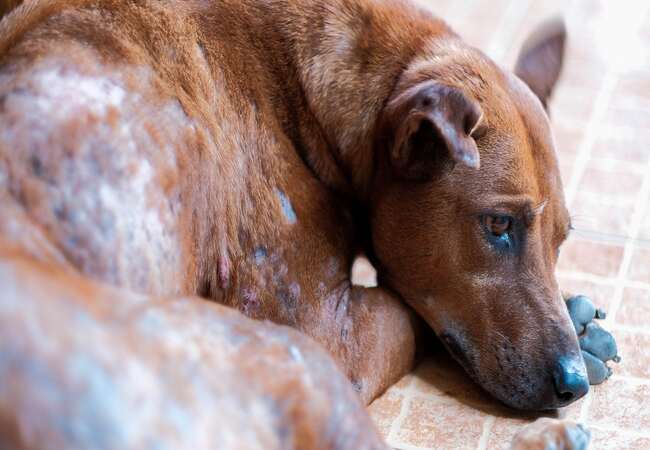Vet’s 2025 Guide to Canine Rashes 🩺 Causes, Diagnosis & Treatment Tips

In this article
Vet’s 2025 Guide to Canine Rashes 🩺 Causes, Diagnosis & Treatment Tips
By Dr. Duncan Houston BVSc
💡 What Are Rashes?
A rash in dogs—technically pyoderma or dermatitis—is an outbreak of scaly, red, bumpy or swollen skin that’s often itchy and sometimes painful. Rashes frequently appear on the belly, groin, paws, ears, or joints, and may indicate a minor irritation or a more systemic condition.
🚩 Common Signs & Locations
- Red, inflamed patches or bumps on the skin.
- Itching, scratching, licking, chewing.
- Hair loss, flaking, oily or scaly skin.
- Hot spots—moist, oozing sores.
- Common areas: belly, armpits, groin, paws, ears, folds of skin.
🔍 Key Causes
1. Allergies
- Atopic dermatitis: environmental allergens like pollen cause itchy rashes and hot spots.
- Food allergies: year-round rash, GI signs; diagnosed via elimination diet.
- Contact allergies: reaction to materials or chemicals; rash appears at contact site.
2. Parasites
- Fleas: intense itching, excoriations, often at the tail base (flea allergy dermatitis).
- Mites: sarcoptic (highly itchy/scaly), demodectic (patchy, less itchy).
- Ticks, chiggers: bites cause local irritation or carry diseases.
3. Infections
- Bacterial (pyoderma): pustules, crusts from Staph; often secondary to irritation.
- Yeast: Malassezia leads to greasy odor, darkened skin, recurrent rash in folds.
- Fungal (ringworm): circular, scaly lesions; zoonotic.
4. Physical / Contact Irritants
- Heat rash: hot, humid weather leads to prickly, inflamed bumps.
- Hives (urticaria): from insect bites, food, or stress; raised red welts.
- Lick granuloma: self-inflicted lesion from stress/itch relief, becomes thick & ulcerated.
5. Endocrine / Immune & Systemic Conditions
- Hypothyroidism, Cushing's—readily itchy, scaly skin.
- Autoimmune diseases—pemphigus, lupus, cause pustular or crusty rashes.
- Metabolic issues like diabetes can predispose to recurrent infections.
🧪 Diagnostic Steps
- History & examination: onset, seasonality, behavior, environment.
- Skin cytology: detects bacteria, yeast, inflammatory cells.
- Fecal/skin scrapings: assess mites, fungal spores.
- Allergy testing: for atopy, food trials.
- Bloodwork & endocrine testing: thyroid, cortisol, CBC/Chem for systemic disease.
- Biopsy: for deep or unusual lesions.
🩺 Treatment Strategies
1. Acute Relief & Topical Care
- Medicated shampoos: antifungal, chlorhexidine, oatmeal to calm and clean.
- Topical sprays, wipes, creams for itch control.
- Oatmeal or chamomile soaks for soothing benefits.
- Clean, dry hot spots, clip fur, and apply antiseptics.
- Use E-collars to prevent self-trauma.
2. Systemic Medications
- Oral antibiotics for bacterial pyoderma.
- Antifungals for yeast or ringworm cases.
- Antihistamines or corticosteroids for allergies/hives.
- Parasite treatments—flea control, acaricides for mites/ticks.
- Psych medications or behavior therapy for lick granulomas.
3. Managing Underlying Issues
- Allergy management: immunotherapy, fatty acid supplements.
- Food elimination trials for suspected food allergies.
- Treat endocrine disorders with appropriate hormonal therapy.
4. Supportive Care & Nutritional Support
- Omega‑3/-6 fatty acid supplements, vitamins A, E, and zinc to support skin barrier.
- Regular grooming, hypoallergenic diets to reduce flare risk.
📅 Monitoring & Prevention
- Recheck skin at 2–4 weeks; repeat diagnostics if not resolved.
- Maintain parasite control year-round.
- Rotate topical treatments; beware of contact irritants.
- Daily grooming and hygiene to catch signs early.
- Allergy flare management with medication and avoidance.
🏡 Ask A Vet Home Support
- Upload photos/videos of rashes and behavior changes.
- Track symptoms, medication schedules, grooming routines.
- Get reminders for treatments, rechecks, vaccines, and flea/tick preventives.
- Receive alerts for worsening signs: spreading rash, smell, fever).
- Educational tips: bathing routines, diet, and escaping allergens.)
🔑 Key Takeaways
- Dog rashes are common but often treatable—caused by allergies, parasites, infections, or behavior.
- Accurate diagnosis requires skin tests, cytology, and clinical history.
- Treatment must match the cause: topicals, meds, lifestyle change, nutrition.
- Prevention: hygiene, parasite control, allergy management, diet & grooming.
- Ask A Vet supports every step: monitoring, reminders, advice, and early detection.
🩺 Conclusion ❤️
Canine rashes range from mild to severe, but with thorough veterinary assessment, clear diagnosis, and a tailored treatment plan, most dogs improve quickly. In 2025, combining modern veterinary approaches with home-based care via Ask A Vet empowers owners to confidently manage skin health. That itchy pup? With proper care, comfort is just a click away. 🐶✨
Visit AskAVet.com and download the Ask A Vet app to log skin changes, receive treatment reminders, upload photos, and stay connected with your vet—right from your home. 📲






